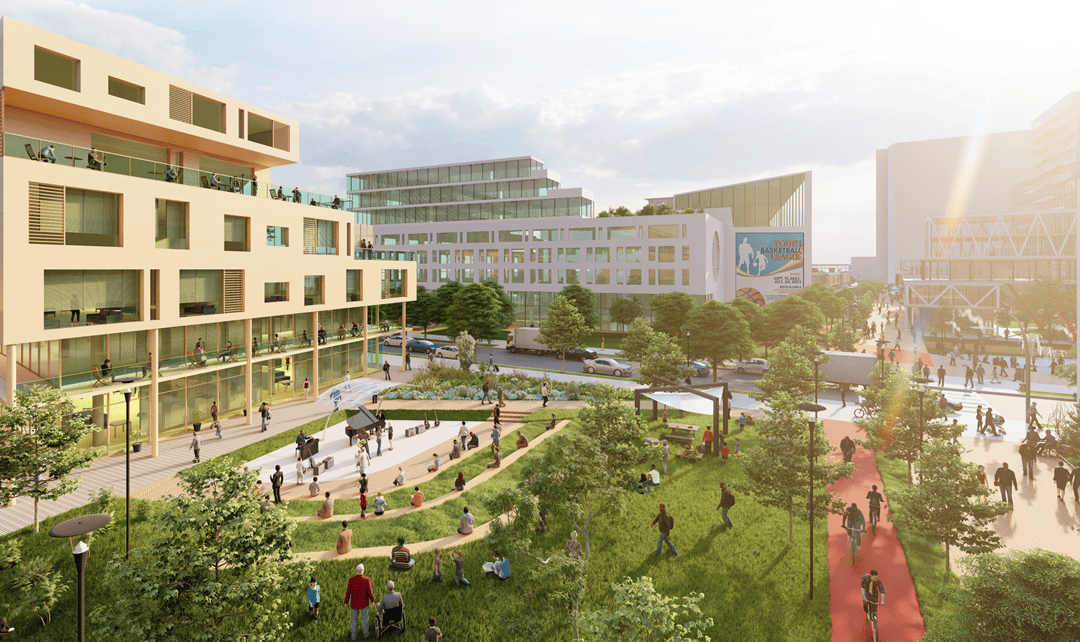Talk about pressure. One hundred and five teams from 61 universities in Canada, the United States and Singapore had two weeks to come up with a redevelopment plan for an eight-block Missouri neighbourhood. Toronto’s Fusion team walked away with the top prize in the 2021 Urban Land Institute Gerald D. Hines Student Urban Design Competition that wrapped up in April.

Fusion team members are Frances Grout-Brown and Leorah Klein of Ryerson University, Ruotian Tan and Chenyi Xu of the University of Toronto and Yanlin (Lynn) Zhou of York University.
Their winning $655-million mixed-use, mixed-income redevelopment plan for an East Village neighbourhood in downtown Kansas City includes a 165,000-square-foot incubator to foster economic growth; a network of community gardens to address food deserts and create agriculture jobs; rain gardens and a tree canopy to mitigate floods and extreme heat; green infrastructure such as bike lanes and multi-block pedestrian ways to reduce greenhouse gasses; and affordable housing.

“Fusion stood out as it pushed a new paradigm for an urban neighbourhood based on the strong regional legacy of agriculture. Their financing plan and design enabled economic resilience through small-scale food growth and distribution, local culinary incubation and research-driven employment opportunities,” says a statement from Diana Reid, the ULI Hines jury chair on why the Toronto students were selected as this year’s winners. “Fusion’s food-based approach and focus on inclusive and sustainable growth created a complete vision of a new urban neighbourhood in East Village, including ambitious housing affordability targets, smart community partnerships, strong pedestrian and multi-modal transportation, and connectivity to and through the site.”
The team members, mostly strangers before the competition, came together in the “rapid-fire environment,” each determined to give the task their all. “Everyone has a different skill set but worked together smoothly,” says Tan (Master of Urban Design). Xu (Master of Architecture) agrees, saying, “We became a very efficient team in a short time.”
Klein (Master of Urban Planning) says they were lucky to have such an exceptional team dynamic, with everyone open to each other’s ideas and iterating the design, and everyone committed and excited to see how far they could take the project.
One of the judges said it was clear how well the team works together, as demonstrated in their plan, slide deck and presentation.
Klein says she appreciated the real-life nature of the competition – designing for an existing site and with a multi-disciplinary team reflective of working in the real world. Each member focused on their area of expertise but all contributed to the entire project and supported one another.
Klein and Grout-Brown (Master of Urban Planning) were tasked with research, finding a name that would accurately describe the plan’s intensions and to create a narrative that would fully communicate the intricacies of the redevelopment plan to the judges.
Grout-Brown and Klein thought about “disparate parts coming together to form something different…Fusion also brings to mind culinary fusion, where different elements of food come together,” says Klein. It was perfect for a plan in which food plays a major role.
Tan says the Kansas City neighbourhood is a food desert and “we wanted to use the food industry as a catalyst.”
Tan says he and Xu were responsible for the urban design/architecture portion, including the layout, density and landscape strategies. They developed an underground storm water management system for the whole site based on existing topography.
Tan came up with the master plan and Xu was mainly responsible for modelling and renderings. Xu says, “Since I am the only architecture student in the Fusion group, after Tan planned the entire site, I began to design each building individually….In this project, I am proud of the community centre I designed. I set up an open atrium in the entire building, and in the words of the judges, the community centre is very much like a stadium (the citizens of Kansas City are very passionate about sports). In fact, it is not a stadium, but the multi-functions it provides are better than the single function of the stadium.”
Zhou’s task was to ensure the project was financially feasible. Zhou (Master of Real Estate and Infrastructure) used a mix of public and private funding, with land acquisition from the government at almost no cost and ensuring the return made sense for investors. She also helped envision the site, did market research to determine the amount of housing it would include and introduced the vertical garden idea.
All five contributed to all parts of the project, giving it a sense of continuity, Grout-Brown says. Although the plan was developed specifically for the Kansas City site, team members took what they appreciate in Toronto as inspiration, including the pedestrian-friendly Distillery District and the pedestrian-oriented and mixed-income Regent Park neighbourhood, Klein says.
The Fusion plan could be tweaked for use in other locations, Tan says. Grout-Brown says certain parts of the plan could translate for use in Canada, but high land values in certain areas are a roadblock.
However the quicker approvals process and lower land value worked in Kansas City’s favour, Zhou says.
All of the team members are in their last year of masters studies. Tan has a summer internship but wants to work full-time as an urban designer. Grout-Brown is working part-time at Ryerson Community Housing Strategies. Xu hopes to work at a local architectural firm. Klein has started her career in real estate development working part-time as a development associate at Diamond Corp, a developer of mixed-use communities in Toronto. Zhou is starting an internship with a local developer. After her summer semester, her goal is to work full-time with a local developer.
“The urban planning community in Toronto is relatively small. I feel and hope our paths will cross. We have an awesome dynamic team and I’d love to work together again,” Klein says.
Grout-Brown says, “The competition was a great way to end our academic careers.”
The ideas competition provides graduate students the opportunity to create a comprehensive design and development scheme for a large-scale site in an urban area. The Fusion team was awarded a $50,000 prize at the conclusion of the competition, says a ULI press release.
Connie Adair is a contributing writer for REM.












